Sustained activation of Lyn tyrosine kinase in vivo leads to autoimmunity
- PMID: 12486102
- PMCID: PMC2196073
- DOI: 10.1084/jem.20020515
Sustained activation of Lyn tyrosine kinase in vivo leads to autoimmunity
Abstract
Genetic ablation of the Lyn tyrosine kinase has revealed unique inhibitory roles in B lymphocyte signaling. We now report the consequences of sustained activation of Lyn in vivo using a targeted gain-of-function mutation (Lyn(up/up) mice). Lyn(up/up) mice have reduced numbers of conventional B lymphocytes, down-regulated surface immunoglobulin M and costimulatory molecules, and elevated numbers of B1a B cells. Lyn(up/up) B cells are characterized by the constitutive phosphorylation of negative regulators of B cell antigen receptor (BCR) signaling including CD22, SHP-1, and SHIP-1, and display attributes of lymphocytes rendered tolerant by constitutive engagement of the antigen receptor. However, exaggerated positive signaling is also apparent as evidenced by the constitutive phosphorylation of Syk and phospholipase Cgamma2 in resting Lyn(up/up) B cells. Similarly, Lyn(up/up) B cells show a heightened calcium flux in response to BCR stimulation. Surprisingly, Lyn(up/up) mice develop circulating autoreactive antibodies and lethal autoimmune glomerulonephritis, suggesting that enhanced positive signaling eventually overrides constitutive negative signaling. These studies highlight the difficulty in maintaining tolerance in the face of chronic stimulation and emphasize the pivotal role of Lyn in B cell signaling.
Figures

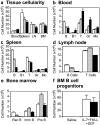
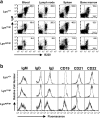
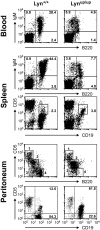

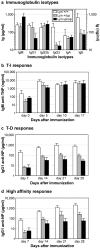
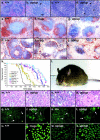
Similar articles
-
Genetic interdependence of Lyn and negative regulators of B cell receptor signaling in autoimmune disease development.J Immunol. 2012 Aug 15;189(4):1726-36. doi: 10.4049/jimmunol.1103427. Epub 2012 Jul 13. J Immunol. 2012. PMID: 22798664
-
Defective negative regulation of antigen receptor signaling in Lyn-deficient B lymphocytes.Curr Biol. 1998 May 7;8(10):545-53. doi: 10.1016/s0960-9822(98)70223-4. Curr Biol. 1998. PMID: 9601638
-
A CD19-dependent signaling pathway regulates autoimmunity in Lyn-deficient mice.J Immunol. 2001 Sep 1;167(5):2469-78. doi: 10.4049/jimmunol.167.5.2469. J Immunol. 2001. PMID: 11509585
-
Signaling mutations and autoimmunity.Curr Dir Autoimmun. 2003;6:61-88. doi: 10.1159/000066856. Curr Dir Autoimmun. 2003. PMID: 12408047 Review.
-
Lyn tyrosine kinase: accentuating the positive and the negative.Immunity. 2005 Jan;22(1):9-18. doi: 10.1016/j.immuni.2004.12.004. Immunity. 2005. PMID: 15664155 Review.
Cited by
-
B-cell anergy: from transgenic models to naturally occurring anergic B cells?Nat Rev Immunol. 2007 Aug;7(8):633-43. doi: 10.1038/nri2133. Epub 2007 Jul 20. Nat Rev Immunol. 2007. PMID: 17641666 Free PMC article. Review.
-
Acute Csk inhibition hinders B cell activation by constraining the PI3 kinase pathway.Proc Natl Acad Sci U S A. 2021 Oct 26;118(43):e2108957118. doi: 10.1073/pnas.2108957118. Proc Natl Acad Sci U S A. 2021. PMID: 34675079 Free PMC article.
-
CD45, CD148, and Lyp/Pep: critical phosphatases regulating Src family kinase signaling networks in immune cells.Immunol Rev. 2009 Mar;228(1):288-311. doi: 10.1111/j.1600-065X.2008.00752.x. Immunol Rev. 2009. PMID: 19290935 Free PMC article. Review.
-
A computational model for early events in B cell antigen receptor signaling: analysis of the roles of Lyn and Fyn.J Immunol. 2012 Jul 15;189(2):646-58. doi: 10.4049/jimmunol.1102003. Epub 2012 Jun 18. J Immunol. 2012. PMID: 22711887 Free PMC article.
-
Quantitative differences in CD45 expression unmask functions for CD45 in B-cell development, tolerance, and survival.Proc Natl Acad Sci U S A. 2012 Jan 3;109(1):E3-12. doi: 10.1073/pnas.1117374108. Epub 2011 Nov 30. Proc Natl Acad Sci U S A. 2012. PMID: 22135465 Free PMC article.
References
-
- Healy, J.I., and C.C. Goodnow. 1998. Positive versus negative signaling by lymphocyte antigen receptors. Annu. Rev. Immunol. 16:645–670. - PubMed
-
- O'Keefe, T.L., G.T. Williams, S.L. Davies, and M.S. Neuberger. 1996. Hyperresponsive B cells in CD22-deficient mice. Science. 274:798–801. - PubMed
-
- Sato, S., A.S. Miller, M. Inaoki, C.B. Bock, P.J. Jansen, M.L. Tang, and T.F. Tedder. 1996. CD22 is both a positive and negative regulator of B-lymphocyte antigen receptor signal transduction: altered signaling in CD22-deficient mice. Immunity. 5:551–562. - PubMed
-
- Otipoby, K.L., K.B. Andersson, K.E. Draves, S.J. Klaus, A.G. Garr, J.D. Kerner, R.M. Perlmutter, C.-L. Law, and E.A. Clark. 1996. CD22 regulates thymus independent responses and the lifespan of B cells. Nature. 384:634–637. - PubMed
-
- Nitschke, L., R. Carsetti, B. Ocker, G. Kohler, and M.C. Lamers. 1997. CD22 is a negative regulator of B cell receptor signaling. Curr. Biol. 7:133–143. - PubMed
Publication types
MeSH terms
Substances
LinkOut - more resources
Full Text Sources
Other Literature Sources
Molecular Biology Databases
Miscellaneous

